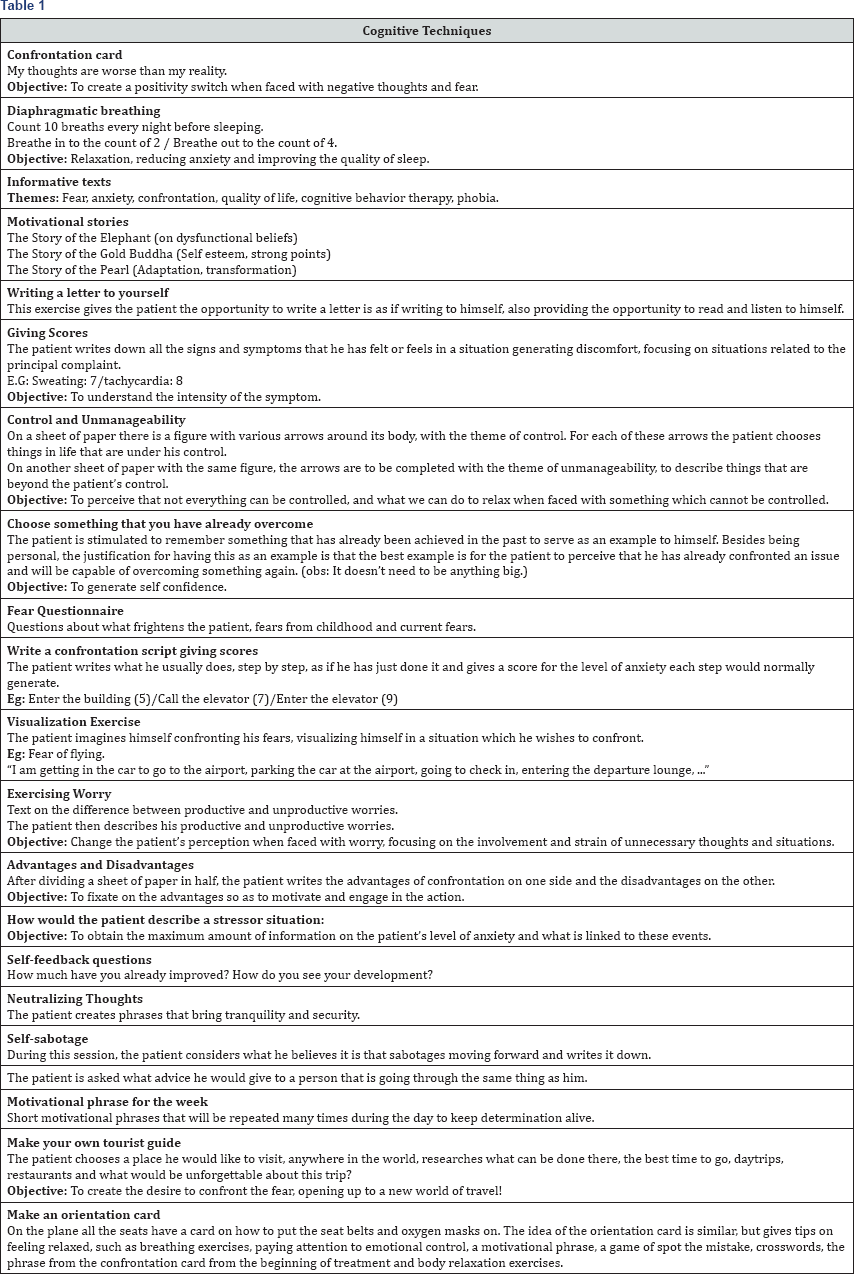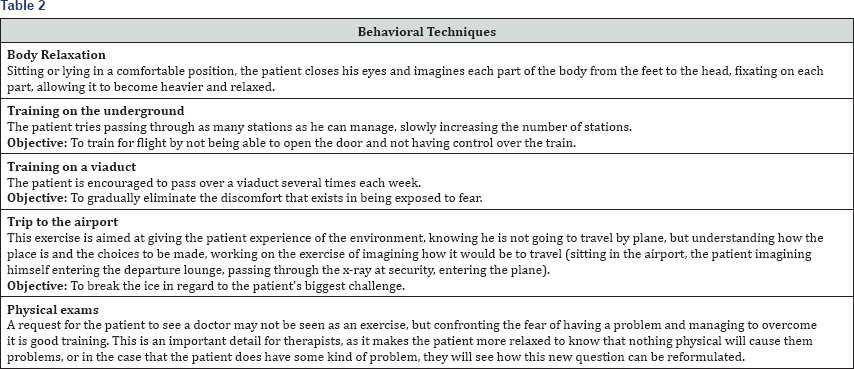Report of a Clinical Case in Agoraphobia: The Challenge to Fly-Juniper Publishers
Global Journal of Intellectual & Developmental Disabilities (GJIDD)
This is a report of a clinical case in which the
patient wishes to modify dysfunctional avoidance behavior, in order to
be able to confront his fears of elevators, high places and planes. The
presence of activator tasks between sessions as motivation for the final
objective was of significant importance. Cognitive behavior therapy was
used as base methodology. It was concluded that it is an effective and
tangible treatment for the agoraphobic, providing assistance and
bringing success and applicability in this case [1].
Keywords: Agoraphobia; Systematic desensitization; Cognitive behavior therapyIntroduction
This study has the objective of reporting a clinical
case of cognitive behavior therapy, which is short term structured
therapy, focused on the resolution of problems. According to Cognitive
Behavior Therapy, the therapist teaches the client to respond to
negative emotional states in an adaptive way. Clients frequently
describe their bodily state corresponding to internal processes: "it is horrible to feel like this", or to suppression of behavior: "I literally paralyze myself".
It is the responsibility of the therapist to
demonstrate the action of aversive events in the client's life and lead
them to discriminate how such events acquire aversive functions.
According to IDC-10 (WHO, 1993), the term agoraphobia refers to the fear
of leaving the house, fear of public places, fear of crowds or the fear
of travelling alone on trains, cars, buses or planes [2].
The lack of a way out or available help is a key aspect of the
disorder. It is the most incapacitating of the phobic disorders, causing
some patients to remain completely confined at home. In the absence of
effective treatment, agoraphobia frequently becomes chronic.
According to Fyer & Coplan [3],
the prevalence of agoraphobia in the general population during life is
2.5 to 6.5%. In clinical populations, agoraphobia is almost never seen
without a concurrent history of panic attacks or panic disorder.
Formulation of the case
Brief case description: The patient is a 62
year old accountant who owns and runs a small accounting business. He
likes having things under control and well defined. He reports a desire
to travel by plane, which he has never managed to do due to fear. He is
married to a patient wife who always provides assistance. They have two
children that no longer live with them, as they live with their
respective partners. Due to his age and having an easier schedule, he
feels more necessity to break this barrier and be able to travel and
know places he would no longer go to by car. It is important to
emphasize that the supposed fear that he reports goes beyond the barrier
of planes, also including fears such as elevators and high places [4].
Initial experiences: The patient suffered a
difficult childhood, with his parents working hard to pay for his
studies, without the financial conditions to buy much beyond what was
necessary to feed him and his brothers. When he was a child he had the
desire to have a good job, a more comfortable home and to provide his
future children with things that he was not able to receive from his
parents.
Central beliefs
"I won't be able to stay there with the door closed.”
"I need to know how to get out.”
Intermediate beliefs
"I won't feel well.”
"I won't have control.”
"I need to know how everything will be.”
Strategies of the patient
He never takes the elevator alone or when it is very
full, in which case he takes the stairs. When travelling by car he takes
a route that avoids high places. In regard to airplanes he has no
strategies and no excuses not to take a flight.
Behavior maintainer
As he always has to be in control of everything; the
business, the family, himself; his maintainer is control; being aware of
and understanding everything that is happening.
Event
The landmark event in relation to this case occurred
in his adolescence at a football match at the Maracana stadium, where,
to maintain the groups of fans in order, the exits werelocked. He felt
imprisoned, without a way out, becoming desperate and feeling awful. He
remembers that since that day he has always worried about finding the
exit, and about knowing that he could come and go. Recently he didn't
feel well inside his car on the Rio-Niteroi Bridge, experiencing various
symptoms such as tachycardia and tensed muscles, which is when he
realized that he really needed help [5].
Symptoms
Dry mouth, tachycardia, tingling, hot flushes, tensing of the muscles.
Automatic thoughts
"I have to take care of everything.”
"I mustn't be foolish.”
Emotions
Sadness, fear, anguish and anxiety.
Behavior
Paralysis faced with what is desired; searches for a way to have more time so as not to resolve the situation (avoidance).
Consequence
Delay in seeking and accepting help Paralysis faced
with what is desired; searches for a way to have more time so as not to
resolve the situation (avoidance).
List of problems reported by the patient
I need to use the elevator without fear, as the office is on the tenth floor.
I really want to travel with my family without thinking that we are going to fall from high places, leaving them in a panic.
I would like to know a little of the world, as I have worked so much and have the financial resources to travel.
Strategies
As he does not know how to deal with these
situations, he has resorted to psychotherapy on the recommendation of a
close personal friend. Despite still disbelieving, he resolved to accept
the recommendation and try this alternative to remove his discomfort.
In the first session together we questioned alternatives, his thoughts
and beliefs on how we might develop the treatment.
Text on the Case
The patient arrives with the complaint of not being
able to take the elevator, problems driving through high places and
having the desire but never having been able to travel by plane. He had
already considered seeking psychological help, but had put it off as he
thought it wasn't necessary and didn't think it would be of great value.
After having a panic attack in the car while crossing the Rio-Niteroi
Bridge, tensing up his muscles and experiencing tachycardia and
excessive sweating, remaining paralyzed and taking a long time to return
to a relaxed state, he realized that he would need help. It was
discussed in depth how much the patient desired to improve, what would
change, what the gains would be, how affective he believed it would be
and how dedicated he would be. Strategic planning for the treatment was
then started, commencing with psycho education on what constitutes fear,
phobia and panic attack, what cognitive behavior therapy is, and
desensitization. It is worth emphasizing that he has a strong memory
that all this began when he was at a football match in the Maracana
stadium and felt imprisoned and suffocated at not being able to exit the
stadium. His profession is in the area of accountancy, working in a
managerial role in an accountancy office. He often reports the anxiety
in his thoughts: "I need to know I can get out”. His principal symptoms
are dry mouth, tachycardia, tingling sensation, hot flushes and tensing
of the muscles. The exercises were the strong point of the case, given
that they created a new perception on what he thought, reconstructing
his belief in impossibility. The first step to be overcome was the
elevator, which was upsetting him greatly as he had to take an elevator
every day. Subsequently, we moved on to doing exercises for high places,
before coming to underground trains, which were not the focus, but he
hadn't used them for some years and they were good training for the
airplane in terms of lack of control of the door and the opportunity to
remain seated and relaxed, gradually increasing the number of stations
that the train passed.
Activities performed in the clinical case
All the activities carried out in the case, which
were essential for the efficacy of the treatment, are listed below, and
divided by cognitive technique and behavioral technique [6].
Results
With the use of desensitization and performance of the various activities described in the tables 1 & 2
above, a great improvement was perceived. The patient reported no
longer having problems taking the elevator and that his discomfort with
high places had been greatly reduced.


In the second session after triage, Beck's Anxiety
Inventory was applied, with a result equivalent to 60 points
(demonstrating an extremely concerning level of anxiety). After twenty
sessions the inventory was applied again, with a significant
improvement, the result having been 15 points (demonstrating a low level
of anxiety) [7].
The patient made his first short flight (Rio-Sao
Paulo), together with his wife and in the company of the therapist,
which involved a great deal of work and motivation. The therapy sessions
were increased to twice weekly one month before the flight, in order to
increase the patient's determination and confidence. On the day of the
flight many techniques were used such as relaxation, positive thinking
and occupying idle time. The trip was a great success with the patient
remaining calm and relaxed until landing, full of joy and pride at
having overcome something he had desired for over 50 years. A new target
of repeating the flight without the therapist was established in order
to continue this action of confrontation and desensitization.
Consequently, it can be concluded that the more
opportunities the patient has to be in contact with that which he
desires to confront, the lower his discomfort becomes, as a result this
generates the security to repeat the action.
It can be observed that this demonstrates that
reinforcing the confrontation behavior brings the security and
confidence required to achieve the desired results, with the assistance
of the techniques and the application of Beck's inventory [8].
Conclusion
It was concluded that the technique of systematic
desensitization is effective, in both the applied activities and Beck's
Anxiety Inventory, which reinforces that cognitive behavior therapy
brings these techniques as a construct that assists in perception,
motivation, attention and engagement of the patient in the treatment. It
also reinforces the possibility of formulation of the case as a solid
structure for therapeutic strategies and defined goals within an
agreement framework with the patient. The case study presented here
illustrates the typical behavior of a person who avoids situations which
evoke unpleasant bodily sensations. The procedures used were effective
in teaching the patient to reduce and manage such sensations.
The patient learned to discriminate his negative
emotional states, as well as the detailed process of his own reaction
when in these states. He also learned to reduce the associated
physiological responses and commemorated each step that was
accomplished, taking more and more control of his problems.



Comments
Post a Comment